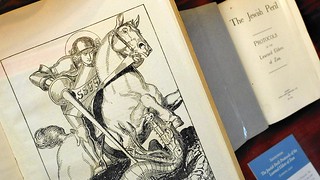
PREV ARTICLE
NEXT ARTICLE
FULL ISSUE
PREV FULL ISSUE
EXHIBIT: THE FAKES, LIES AND FORGERIESHere's another non-numismatic article about a topic of interest to both
bibliophiles and numismatists: fakes and forgeries. Thanks to Fred Michaelson for sending this item
from the Baltimore Sun. -Editor
In the age of Photoshop, James Frey and various forms of Internet chicanery, never has an exhibit on the fine art of lying been more timely. Now Baltimore is poised to become the epicenter of forgery studies internationally, thanks to a recent acquisition of what arguably is the world's largest collection of historically significant phony documents. "It takes a lot of intellect, creativity and imagination to pull off a forgery," said Earle Havens, the library's curator of rare books and manuscripts and the exhibit's co-curator. "Forgery appeals to a fundamental aspect of human nature — our predilection to deceive. This is the naughty bits of history." About 70 of the most famous literary and historical forgeries are on view, dating from roughly the 12th century to the middle of the 20th. Each of the flim-flam men who created them succeeded, at least for a time. A few changed history. "Sometimes, the motivation for the forgeries was to do what we're doing now — talking about them 400 years later," Havens said. "If you can't get famous for the genius of your poetry, maybe you can get famous for being one of the best liars in the history of the world." The exhibit, which runs through Feb. 1, is culled from a 1,700-item collection of literary and historical counterfeits and frauds amassed by a London couple over half a century. The Fakes, Lies and Forgeries," was partly sold and partly donated to the Johns Hopkins University in 2011 by Arthur and Janet Freeman. Anthony Grafton, a history professor at Princeton University and the author of the book "Forgers and Critics," described the holdings as "the greatest collection of its kind in the world." "There's nothing like it anywhere else," Grafton said. "Great institutions like the British Library have lots of forgeries, but they're spread throughout the collection. Here, the books are together and they kind of talk to each other when you're working on them. In the future, anyone who's seriously interested in studying forgery will have to go to Baltimore." Here are just a couple examples - be sure to read the complete article for more.
Amazing. -Editor
Bata Kindai Amgoza Ibn LoBagola
So he decided to become someone else. In particular, LoBagola decided to become a black Jewish prince and self-proclaimed former savage who hailed from a remote part of Africa. Oh, and did LoBagola mention that he also was descended from one of the lost tribes of Israel? In 1930, he persuaded a leading American publisher, Alfred A. Knopf, to bring out his life story; a copy of that book is in the exhibit. "He decided to emancipate himself," Havens said. "There's something very American about being rebellious and chafing against restriction." Protocols of the Learned Elders of Zion
"It's an ugly story," Havens said, "a terrible, pernicious lie that caused the deaths of millions of people." To read the complete article, see:
 Wayne Homren, Editor The Numismatic Bibliomania Society is a non-profit organization promoting numismatic literature. See our web site at coinbooks.org. To submit items for publication in The E-Sylum, write to the Editor at this address: whomren@gmail.com To subscribe go to: https://my.binhost.com/lists/listinfo/esylum All Rights Reserved. NBS Home Page Contact the NBS webmaster 
|
